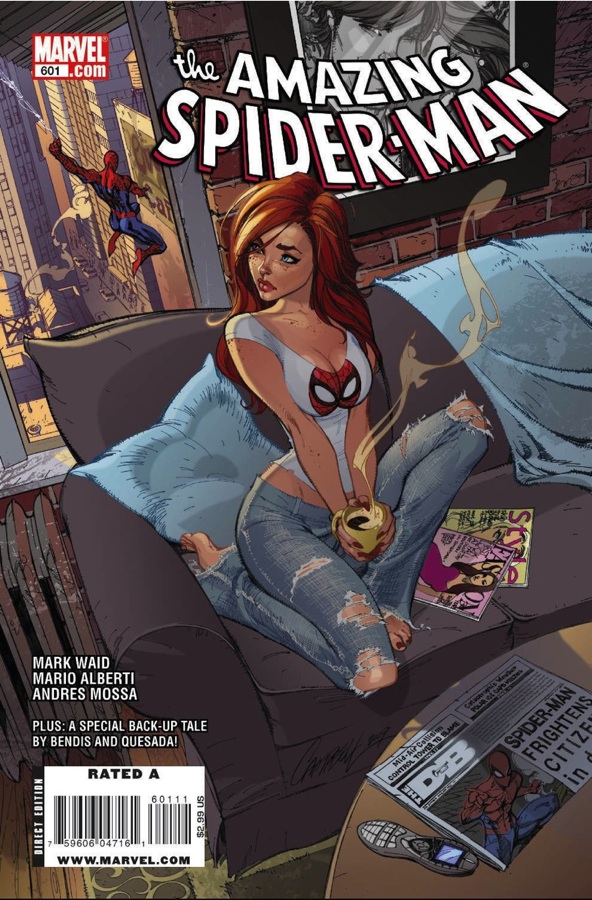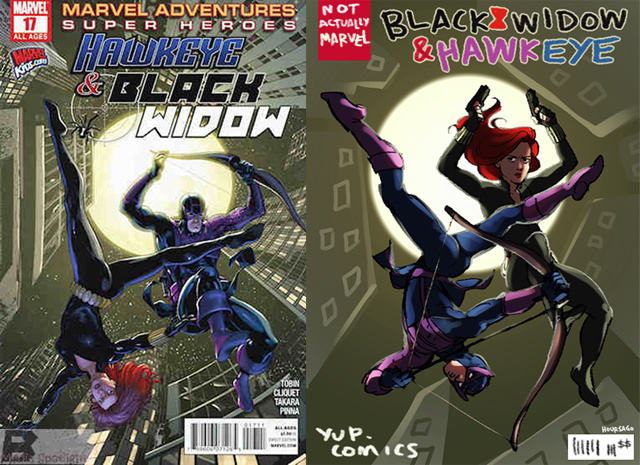
Image Credit: Comic Book Resources
What's so amazing about Spiderman? Setting aside the superpowers and the solid-gold heart, his greatest talent appears to be marketing. On this 2009 J. Scott Campbell cover, Spidey appears in three different ways: swinging away in person from his on-again-off-again love interest, caught in an action shot on the cover of a newspaper, and staring out at the viewer from an impressive vantage point on Mary Jane's t-shirt. If we think of “amazing” in terms of “eyecatching,” which Spiderman lives up to his full hero title? From a framing standpoint, it's the front-and-center shirt version, the version showcasing Mary Jane's ample breasts. On this cover, The Amazing Spiderman, much like The Amazing Spiderman, draws focus away from the hero himself and onto an idealized female form.
Mary Jane herself features on this cover in an interesting way. Aside from the unrealistic proportions and the highly uncomfortable-looking pose, she also has a few media echoes that emphasize her value as an object instead of a character. Like the newspaper on the coffee table, she has provided the blank ad space necessary for housing Spiderman's image. Mary Jane has effectively become a walking Spiderman news column, and the steaming coffee she clutches not only cheekily reminds the viewer just how “hot” she happens to be, but just how hot off the presses Spiderman's story is. The fashion magazines beside her on the couch feature women on their covers filling a function very similar to her own: they're there to help sell issues. In the world of fashion magazines, it's about selling a certain look. In the world of comic books, it's about selling the female body itself as a consumable item.
Some invested individuals in various online communities, however, aren't buying what's being sold. They pepper the internet with scathing parodies that provide visual counterpoints to overt sexualization of women in visual media. Fan reinventions, for instance, seek to illustrate what they see as the artist's senseless objectification by redrawing this particular Mary Jane cover, toning down the sexy pose and concentrating on her facial expression. The Escher Girls blog includes several impressive examples. Escher Girls itself is devoted to archiving instances of anatomical impossibility in popular culture that hypersexualize the female body, instances that tend to rely on twisting the spine to show off both breasts and rear. Other critics have mocked the cover by trying (and necessarily failing) to mimic the contorted pose in real life.

Image Credit: The Hawkeye Initiative
The Hawkeye Initiative is another homegrown internet movement that sprang up to denounce gender double standards. According to the website, The Hawkeye Initiative “uses Hawkeye and other male comic characters to illustrate how deformed, hyper-sexualized, and impossibly contorted women are commonly illustrated in comics, books, and video games.” Swapping a tantalizingly-arranged female character for a typical male counterpart helps demonstrate the egregious sexualization of women in these genres. While portrayals of idealized women thrive in the mainstream comics industry, an online counterculture of visual commentary questions the politics of the sexy pose.


Recent comments
2 years 29 weeks ago
2 years 44 weeks ago
2 years 44 weeks ago
2 years 50 weeks ago
3 years 4 weeks ago
3 years 4 weeks ago
3 years 4 weeks ago
3 years 6 weeks ago
3 years 6 weeks ago
3 years 6 weeks ago